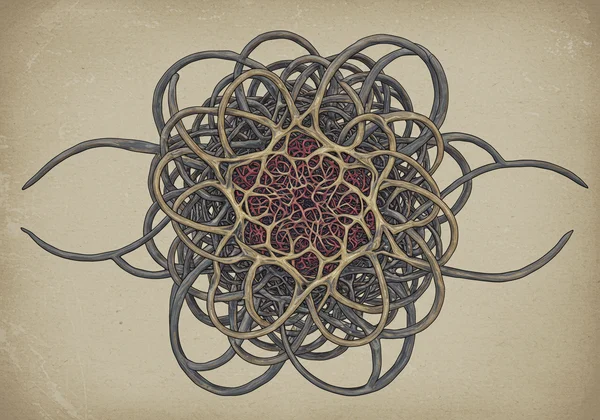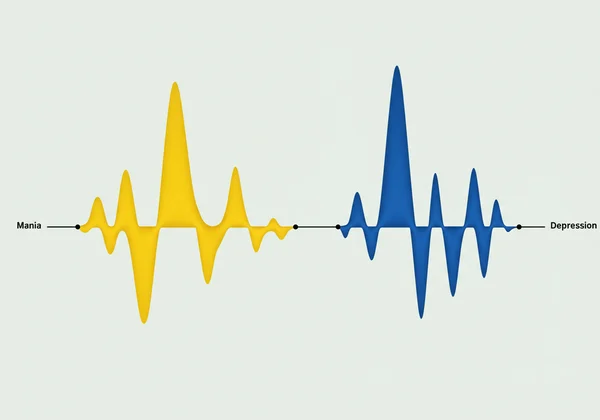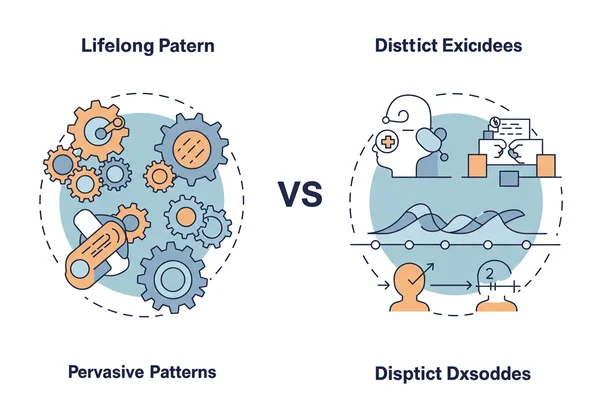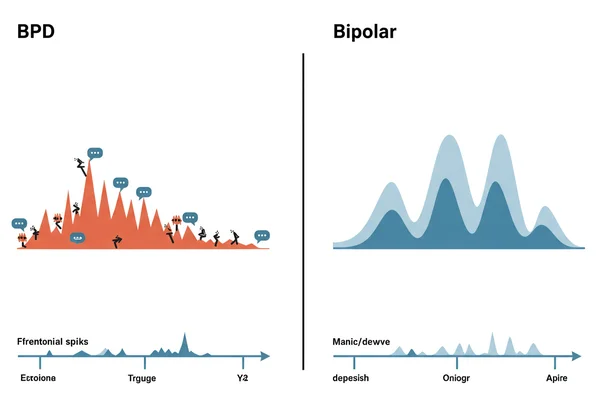Personality Disorder vs. Mood Disorder: How to Tell the Difference (BPD vs. Bipolar Personality Disorder Test)
Intense emotional shifts, relationship difficulties, and an unstable sense of self can be confusing. Do these symptoms point to a personality disorder or a mood disorder? Many people ask, How do I check if I have a personality disorder? While only a professional can provide a diagnosis, understanding the fundamental differences is a crucial first step. This guide clarifies the distinctions between these conditions to help you better understand your experiences.
Gaining self-awareness is key. A confidential online screening can offer preliminary insights. To explore your patterns, you can start a free screening on our platform.
Understanding Personality Disorders: Pervasive Patterns of Self & Behavior
Personality disorders are characterized by long-term, inflexible patterns of thinking, feeling, and behaving that deviate from cultural norms. These patterns are not temporary but are deeply ingrained, affecting how a person perceives themselves, relates to others, and navigates the world. This enduring nature is their defining feature.

Defining Personality Disorders: When Traits Become Inflexible
Everyone has unique personality traits. However, when these traits become rigid and maladaptive, causing significant distress or impairing daily function, they may indicate a personality disorder. The key is inflexibility. A person may struggle to adapt their behavior to different situations, leading to recurring challenges. These are not isolated incidents but inflexible traits that consistently shape their experiences.
Common Personality Disorder Types and Their Presentations
The DSM-5 groups the ten personality disorders into three clusters. Cluster A (paranoid, schizoid) involves odd or eccentric behaviors. Cluster B (borderline, narcissistic) is characterized by dramatic, emotional, or erratic behaviors. Cluster C (avoidant, dependent) involves anxious or fearful behaviors. Understanding these categories can help you learn about traits that may resonate with your experiences.
Understanding Mood Disorders: Episodic Shifts in Emotional State
Unlike the pervasive patterns of personality disorders, mood disorders are defined by significant disturbances in emotional state. These are not constant traits but distinct "episodes" of depression or mania/hypomania. The core feature is a mood disruption that marks a clear change from a person's normal functioning.

Defining Mood Disorders: Beyond Everyday Ups and Downs
While everyone experiences mood fluctuations, mood disorders involve emotional changes that are significantly more intense, prolonged, and disruptive. These are not merely 'bad days,' but clinical conditions marked by persistent sadness (depression) or abnormally elevated moods (mania/hypomania). The defining feature is an episodic change in emotional state.
Common Mood Disorders: Depression, Bipolar, and More
Common mood disorders include Major Depressive Disorder (MDD), marked by major depressive episodes, and Bipolar Disorders (I and II), which involve shifts between depressive and manic/hypomanic episodes. The duration and intensity of these mood episodes are central to their diagnosis and set them apart from personality disorders.
Key Differences: Personality Disorder vs. Mood Disorder
Understanding the core distinctions between these categories is essential. While symptoms can overlap, their underlying structure and duration are fundamentally different. Navigating these complexities is why a preliminary personality disorder test can be a useful tool for self-reflection.

Duration & Stability: Lifelong Patterns vs. Distinct Episodes
The most critical difference is duration. Personality disorders involve lifelong patterns of behavior and inner experience that start early in life and remain stable. For example, Borderline Personality Disorder involves chronic instability in relationships, self-image, and emotions.
In contrast, a mood disorder like Bipolar Disorder is characterized by distinct episodes. A person may experience weeks of a depressive episode, followed by a period of normal mood (euthymia), then a manic episode. Between these episodes, their functioning may be much more stable.
Impact on Identity, Self-Perception, and Relationships
Personality disorders fundamentally shape a person's sense of self and relationships. The difficulties are often ego-syntonic, meaning the person sees their behaviors as normal, even if problematic. Their identity and self-perception are often unstable.
With mood disorders, the primary impact is on mood and energy. While a depressive episode can affect self-esteem, the core sense of self typically remains intact between episodes. The person usually recognizes their mood state is a change from their usual self. Exploring this can help you understand your patterns more clearly.
Diagnostic Criteria and Approaches to Treatment
Diagnosing personality disorders involves identifying long-term, pervasive maladaptive traits. Treatment centers on long-term psychotherapy, like Dialectical Behavior Therapy (DBT), to build healthier coping skills.
For mood disorders, diagnostic criteria focus on the presence and severity of mood episodes. Treatment often combines medication (mood stabilizers, antidepressants) with psychotherapy to manage episodes and maintain stability.
Specific Confusion: Differentiating BPD vs. Bipolar Disorder
The overlap between Borderline Personality Disorder (BPD) and Bipolar Disorder causes common confusion. The difference between BPD and Bipolar is a frequent question. Both involve intense emotions, impulsivity, and mood instability, but their origins and timelines are distinct.

Emotional Dysregulation: Similar Appearance, Different Roots
Both conditions feature emotional dysregulation. In BPD, however, mood shifts are rapid—lasting hours or a day—and typically triggered by interpersonal stress, like a perceived slight. In Bipolar Disorder, mood episodes (depression or mania) last much longer, from days to months, and are less tied to immediate external triggers. A screening tool can help identify the nature of these shifts.
Understanding Narcissistic Traits vs. Bipolar Episodes
Differentiating narcissistic traits from bipolar mania can also be confusing. A person with Narcissistic Personality Disorder (NPD) has a persistent, lifelong pattern of grandiosity and lack of empathy—this is their baseline. In contrast, the grandiosity in a bipolar manic episode is episodic. It's a clear departure from their normal self and subsides when the episode ends.
Your Path to Clarity: Understanding & Seeking Support
Distinguishing between a personality disorder's pervasive patterns and a mood disorder's episodic nature is a key step toward understanding your mental health. This guide offers clarity but isn't a substitute for professional evaluation. Only a qualified mental health professional can provide an accurate diagnosis.
If you recognize your experiences in these descriptions, taking the next step is empowering. Ready for initial clarity? Our free and confidential personality disorder test offers preliminary insights to help you prepare for a conversation with a healthcare provider.
Disclaimer: This article is for informational purposes only and does not constitute medical advice. The screening tool provided is not a diagnostic test. Please consult a qualified mental health professional for an accurate diagnosis and treatment plan.
Frequently Asked Questions About Personality vs. Mood Disorders
How do I know if I should take a personality disorder test?
If you consistently struggle with your sense of self, tumultuous relationships, or distressing emotional reactions across various situations, a test can be a helpful first step. It provides a structured way to reflect on your traits and decide if seeking professional help is the right next move.
What is the most accurate way to get diagnosed?
An accurate diagnosis requires a comprehensive evaluation by a qualified professional, like a psychiatrist or psychologist. This involves clinical interviews, a review of your personal history, and sometimes standardized assessments.
Can a mood disorder turn into a personality disorder?
No, a mood disorder cannot turn into a personality disorder. They are distinct conditions with different causes. However, it is possible for a person to have both a personality disorder and a mood disorder, which is known as co-morbidity.
What's the main difference between personality traits and a disorder?
The difference is flexibility and impairment. Personality traits are flexible, allowing you to adapt. A personality disorder involves rigid traits that appear across most areas of your life (work, relationships) and cause significant distress or functional problems.
What should I do if I think I might have BPD or Bipolar Disorder?
If you suspect you have BPD, Bipolar Disorder, or another condition, the most important step is to speak with a healthcare provider. Start with your primary care doctor or a mental health specialist. In the meantime, a confidential screening tool can help you organize your thoughts before your appointment.